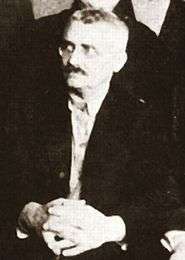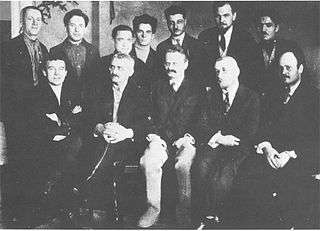Ivan Smirnov (politician)


Ivan Nikitich Smirnov (Иван Никитич Смирнов in Russian) (1881 – August 25, 1936) was a Communist Party activist. He was born in January 1881 in Gorodishche, Moscow Governorate in a family of Russian ethnicity.[1]
In 1899, Smirnov joined the Russian Social Democratic Labour Party and became a Bolshevik. He led his party activity in Moscow, Saint Petersburg, Vyshniy Volochok, Rostov, Kharkov, and Tomsk. Smirnov was subject to repeated arrests. In 1916, he was called up for the military service in a reserve regiment in Tomsk, where Smirnov conducted revolutionary activity. In 1917, he became a member of the executive committee of the Tomsk Soviet. In August of the same year, Smirnov was one of the organizers and upkeepers of the Bolshevist publishing house "Volna" (Wave) in Moscow. He was a deputy of the Constituent Assembly. During the Russian Civil War, Smirnov was a member of the Revolutionary Military Council of the Eastern Front (August, 1918 - April, 1919), and the 5th Army (April, 1919 - May, 1920).
In 1920-1923, Smirnov was a member of the Executive Committee of the Russian Communist Party (Bolsheviks). At the same time, he chaired the Siberian Revolutionary Committee and was a member of the Siberian bureau of the Russian Communist Party (Bolsheviks). Smirnov is known to have had close ties with the Cheka and administered massacres of the rebellious peasants in Tyumen and Altay Mountains. He was the one to organize the capture of General Roman Ungern. In 1921-1922, Smirnov was a secretary of the Petrograd Committee and Northwestern Bureau of the Executive Committee of the Russian Communist Party (bolsheviks). He was the closest associate of Grigory Zinoviev. Smirnov took part in mass executions and deportations from Petersburg of representatives of the "exploiter class".
In April–September 1922 and May–July 1923, Smirnov was a member of the Presidium of Supreme Soviet of the National Economy (ВСНХ) of the RSFSR (between September 1922 and May 1923 - its deputy chairman). In July 1923, Smirnov was appointed People's Commissar for Soviet Postal Services and Telegraph.
In 1923, Smirnov became a proactive member of the Trotskyist opposition. In October 1923 and then in 1927, Smirnov signed the oppositionary "Declaration of 46" and "Declaration of the Eighty-three", which later would seriously affect his position in the party ranks and his life. After Lenin's death, Smirnov publicly insisted on deposition of Joseph Stalin from the post of the secretary general. On November 11, 1927, Smirnov was removed from his People's Commissar post. A month later, he was expelled from the Communist Party by the decision of the 15th Congress. On December 31, 1927, Smirnov was sentenced to three years of exile by the decision of the Special meeting of the OGPU Board.
In October 1929, Smirnov "broke with Trotskyism" and was reinstalled in the Communist Party in May 1930. In 1929-1932, he headed the Saratovkombainstroy trust (Combine assembly in Saratov). In 1932, Smirnov was appointed head of the Department of Erection of New Buildings at the People's Commissariat for Heavy Industry of the USSR. On January 14, 1933, Smirnov was arrested and once again expelled from the party ranks a month later on the basis of allegations that he formed an "anti-party group" in order to remove Stalin.[2]
On April 14, 1933, he was sentenced to five years of labor camps. Still incarcerated, Smirnov was brought to trial as a defendant in the "United Anti-Soviet Trotskyite-Zinovievite Centre" case and sentenced to death on August 24, 1936. He was executed the next day. Smirnov was rehabilitated in 1988.
References
- ↑ "Жертвы политического террора в СССР". Lists.memo.ru. Retrieved 2013-06-13.
- ↑ Allan Todd. The Soviet Union and Eastern Europe 1924-2000. Published 2012, Cambridge University Press. Page 49
External links
- Short biography of Ivan Smirnov on spartacus-educational.com
- The Death of Ivan Nikitich Smirnov by Victor Serge on Marxists.org